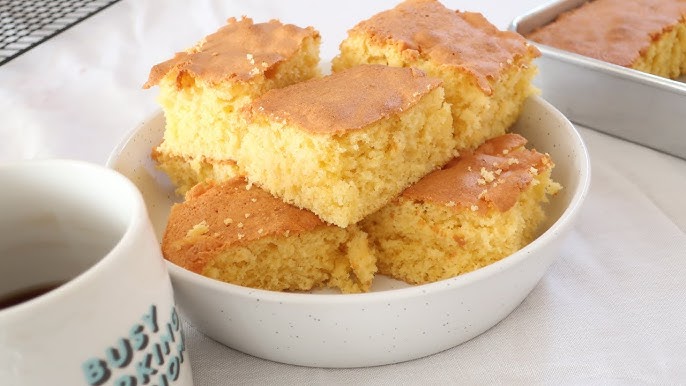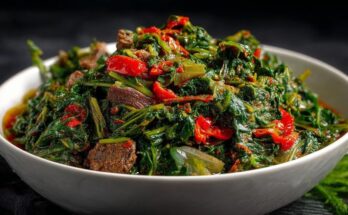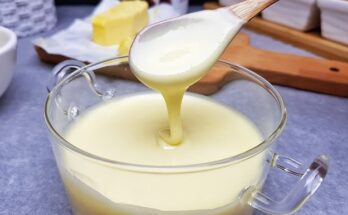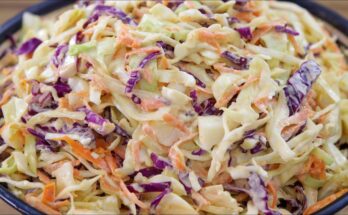Corn Cake Recipe: Corn cake is a delicious, moist, and slightly sweet treat made with cornmeal that has been enjoyed for generations. Whether you’re looking for a quick snack, a dessert for the family, or a side dish to complement a hearty meal, corn cake fits the bill. Its rich texture and comforting flavor make it a favorite across cultures. Unlike traditional cakes that rely solely on flour, corn cake introduces a grainy yet soft bite that sets it apart from other baked goods.
What Makes Corn Cake Special
What makes corn cake truly unique is its versatility. It can be sweet or savory, dense or fluffy, and paired with various toppings such as honey, butter, cheese, or fruit preserves. Unlike cornbread, which is often crumbly, corn cake leans toward being softer, moister, and slightly sweeter, making it a perfect dessert or snack. The golden color from the cornmeal adds to its rustic charm, while the aroma of freshly baked corn cake fills the kitchen with warmth and comfort.
History and Origin of Corn Cake
Corn cake traces its origins back to indigenous communities in the Americas, where corn was a staple crop. Over time, different regions developed their own versions. In Latin America, corn cake is often called pastel de elote or bolo de milho, while in the Southern United States, variations include sweet corn pudding-like cakes. Each culture added its own twist with local ingredients like coconut milk, cheese, or spices. Today, corn cake has become a global comfort food, enjoyed from family gatherings to festive celebrations.
Ingredients You’ll Need
Before we dive into the recipe, let’s go over the essential ingredients that bring corn cake to life. Using fresh and high-quality ingredients makes a noticeable difference in taste and texture.
Basic Ingredients for Corn Cake
Here’s what you’ll need for a traditional corn cake recipe:
- Cornmeal – the star of the show, gives the cake its signature flavor and texture.
- All-purpose flour – balances the density of cornmeal for a softer bite.
- Sugar – adds sweetness; you can adjust depending on your preference.
- Butter – provides richness and moisture.
- Milk – ensures a smooth batter and tender crumb.
- Eggs – act as a binder and add structure.
- Baking powder – helps the cake rise and stay fluffy.
- Salt – enhances flavor and balances sweetness.
Optional Additions for Extra Flavor
Want to elevate your corn cake? Here are some optional ingredients to experiment with:
- Honey or maple syrup – for natural sweetness.
- Cheese – creates a savory twist.
- Vanilla extract – adds depth to the flavor.
- Fresh or canned corn kernels – for extra texture.
- Cinnamon or nutmeg – to add a warm spice note.
Ingredient Substitutes for Dietary Needs
Corn cake is easily adaptable for various diets:
- Use gluten-free flour instead of all-purpose flour for a gluten-free version.
- Replace butter with coconut oil or olive oil for a dairy-free option.
- Substitute cow’s milk with almond, oat, or soy milk.
- Use coconut sugar, stevia, or monk fruit instead of refined sugar for a healthier option.
With these flexible ingredient options, you can customize your corn cake to match your taste and dietary preferences without sacrificing flavor.
Essential Tools and Equipment
To make the perfect corn cake, having the right tools is just as important as having the right ingredients. While the recipe is simple, using proper equipment ensures consistency and makes the process smoother.
Baking Tools You Must Have
- Mixing bowls – at least two, one for wet ingredients and one for dry.
- Measuring cups and spoons – accuracy matters in baking.
- Whisk or electric mixer – for mixing ingredients thoroughly.
- Baking pan – a square, round, or loaf pan works depending on preference.
- Oven thermometer – to make sure your oven is at the correct temperature.
Optional Tools for Better Results
- Sifter – helps aerate flour and cornmeal for a lighter texture.
- Silicone spatula – perfect for folding batter and scraping bowls clean.
- Cooling rack – prevents soggy bottoms by allowing air circulation.
- Parchment paper – for easier cake removal and less mess.
These tools make the baking process easier and more enjoyable, ensuring your corn cake comes out perfectly every time.
Preparing the Ingredients
Preparation is the key to stress-free baking. By organizing and prepping your ingredients before starting, you’ll save time and avoid mistakes during the process.
How to Choose the Best Cornmeal
Cornmeal comes in different textures: fine, medium, and coarse. For a classic corn cake, fine or medium-grind cornmeal works best because it blends well with flour and creates a smooth, tender cake. Coarse cornmeal can make the cake gritty, so it’s best reserved for rustic-style recipes. Always choose fresh, high-quality cornmeal, as old cornmeal can taste stale and ruin the flavor of your cake.
Tips for Prepping Wet Ingredients
- Make sure butter is softened to room temperature for easy mixing.
- Use room-temperature eggs to help them blend better with the batter.
- Warm milk slightly before adding; cold milk can cause uneven mixing.
- If using honey or syrup, measure it in a lightly oiled cup for easy pouring.
Getting Dry Ingredients Ready
- Sift flour, cornmeal, baking powder, and salt together to prevent clumping.
- Mix sugar into the dry ingredients for even distribution.
- Prepare any spices (like cinnamon or nutmeg) ahead of time.
By organizing your wet and dry ingredients separately, you’ll be ready to combine them smoothly when the time comes.
Step-by-Step Guide to Making Corn Cake
Now that you’ve got your ingredients and tools ready, let’s get into the exciting part—baking your corn cake. Follow these steps carefully for the best results.
Step 1 – Preheat and Prepare the Oven
Always start by preheating your oven to 350°F (175°C). A properly heated oven ensures that your corn cake bakes evenly. While the oven is warming up, grease your baking pan with butter or line it with parchment paper to prevent sticking.
Step 2 – Mix the Dry Ingredients
In a large mixing bowl, combine all the dry ingredients: cornmeal, flour, sugar, baking powder, and salt. Use a whisk or sifter to ensure they blend evenly. This step may seem simple, but it’s essential because evenly distributed dry ingredients guarantee that your cake will rise uniformly and have a consistent flavor. If you skip proper mixing, you may end up with pockets of sugar or flour, which can affect the texture and taste.
A good tip here is to lightly whisk in some spice if you’re going for extra flavor—cinnamon, nutmeg, or even a dash of ginger works wonders for adding warmth and depth. If you’re planning to add extra corn kernels or shredded cheese, toss them lightly in flour before mixing them into the dry ingredients. This prevents them from sinking to the bottom of the cake during baking.
Taking your time with this step sets the foundation for a well-balanced batter, so don’t rush through it. Once your dry ingredients are ready, set them aside while you move on to the wet mixture.
Step 3 – Blend the Wet Ingredients
In another bowl, combine butter, milk, and eggs. Beat them together until smooth and creamy. The butter adds richness and moisture, while the eggs give structure, and the milk helps bind everything together for a silky batter. If you want a sweeter or more aromatic cake, add vanilla extract or honey at this stage.
For best results, use an electric mixer at low speed for about 2 minutes, or whisk vigorously by hand until the mixture looks light and frothy. This aeration is what helps the cake turn out fluffy rather than dense. If you’re going dairy-free, replace butter with coconut oil and milk with almond, soy, or oat milk—these substitutes keep the cake moist while adding a subtle new flavor dimension.
One small but effective trick: don’t overbeat the eggs. Mixing just enough to combine them avoids a rubbery texture. Once your wet ingredients are blended smoothly, you’re ready for the most crucial step—bringing the wet and dry mixtures together.
Step 4 – Combine Wet and Dry Mixtures
Now comes the magic moment when everything comes together. Slowly pour the wet mixture into the bowl of dry ingredients. Using a silicone spatula or wooden spoon, gently fold them together until just combined. The keyword here is “just combined.” Overmixing will cause the batter to become tough and dense because it activates too much gluten in the flour.
The batter should look thick but smooth, with no visible lumps of flour. If you’re adding extras like corn kernels, shredded cheese, or spices, fold them in gently at this stage. For a richer texture, you can even swirl in a spoonful of sour cream or yogurt before baking.
Think of this step like tying a delicate knot—you want everything to come together nicely, but not too tightly. Once your batter is ready, transfer it immediately into your greased baking pan. Smooth the top with your spatula for an even finish.
Step 5 – Bake the Corn Cake Perfectly
Place the baking pan in the preheated oven at 350°F (175°C). Bake for about 30 to 40 minutes, depending on the size and depth of your pan. A square pan may take closer to 30 minutes, while a loaf pan might need 40 minutes or slightly longer.
To check if it’s done, insert a toothpick or skewer into the center of the cake. If it comes out clean or with just a few moist crumbs, your cake is ready. If it still looks wet, bake for another 5 minutes and test again.
While baking, resist the temptation to open the oven door too often. Sudden temperature drops can cause the cake to sink in the middle. Instead, trust the process and let the oven do its job. As the cake bakes, your kitchen will fill with the sweet, comforting aroma of golden corn and butter—a sure sign that something delicious is about to be served.
Step 6 – Cooling and Serving
Once your corn cake is baked to perfection, remove it from the oven and place the pan on a cooling rack. Let it cool for at least 10 to 15 minutes before slicing. Cutting too early can make the cake crumble apart since it’s still setting as it cools.
After cooling slightly, slice into squares, rectangles, or wedges depending on your pan. Serve warm for the best experience—especially if you’re pairing it with butter, honey, or a drizzle of maple syrup. For a savory twist, serve alongside soups, chili, or grilled meats. If you prefer a dessert-like feel, top it with whipped cream, fruit preserves, or even ice cream.
The beauty of corn cake is in its versatility. Whether eaten as breakfast with coffee, as a sweet afternoon snack, or as a comforting dinner side, it never fails to satisfy. With each bite, you’ll taste the perfect balance of sweetness, moisture, and that signature cornmeal texture.
Variations of Corn Cake
One of the best things about corn cake is its adaptability. You can tweak the ingredients slightly to create different versions depending on your taste and mood. Let’s explore a few popular variations.
Sweet Corn Cake Recipe
If you have a sweet tooth, you’ll love this version. Simply increase the sugar and add a dash of vanilla extract or honey. For extra sweetness and texture, fold in whole corn kernels or even canned cream-style corn. Some bakers also add a sprinkle of powdered sugar on top after baking for a lovely finish. This variation pairs beautifully with fresh fruit or a scoop of vanilla ice cream.
Savory Corn Cake with Cheese
For those who prefer something less sweet, turn your corn cake into a savory dish by reducing the sugar and adding shredded cheese—cheddar, mozzarella, or even feta for a tangy kick. You can also fold in chopped jalapeños, herbs, or even diced ham for a hearty, flavor-packed version. This savory corn cake makes a fantastic side dish for BBQs, soups, or stews.
Gluten-Free Corn Cake
Good news for gluten-sensitive food lovers—corn cake can easily be made gluten-free. Just swap out the all-purpose flour for a gluten-free flour blend. Since cornmeal itself is naturally gluten-free, this simple substitution ensures everyone can enjoy this classic treat without worry. Adding a touch of xanthan gum helps maintain structure, keeping the cake moist and fluffy.
With these variations, you’ll never get bored of corn cake—it’s a recipe you can reinvent countless times.
Serving Suggestions
One of the most exciting parts of making corn cake is deciding how to serve it. Because of its mild sweetness and tender texture, corn cake pairs beautifully with both sweet and savory dishes. Whether you’re planning a cozy breakfast, a hearty dinner, or a festive gathering, you can always find the right way to present it.
Pairing Corn Cake with Meals
Corn cake makes an excellent side dish for classic comfort meals. Serve it alongside chili, soups, stews, or roasted meats to balance the richness of the main dish with a slightly sweet, grainy texture. In many cultures, it’s enjoyed with barbecue or grilled dishes because it soaks up sauces beautifully. For breakfast, try serving it warm with scrambled eggs and bacon—it’s a filling and wholesome start to the day.
Best Toppings for Corn Cake
If you’re enjoying corn cake as a dessert or snack, the toppings are where you can get creative. Some delicious options include:
- Honey or maple syrup for natural sweetness.
- Fresh fruit or jam for a refreshing fruity touch.
- Whipped cream or vanilla ice cream for a decadent dessert feel.
- Savory toppings like cream cheese, sour cream, or melted butter with herbs.
Experiment with different pairings until you find your favorite. Corn cake is a blank canvas that welcomes almost any topping or side dish.
Storage Tips
Corn cake is best enjoyed fresh out of the oven, but if you have leftovers, proper storage ensures that it stays moist and flavorful for days.
Storing Corn Cake at Room Temperature
If you plan to eat your corn cake within two days, simply wrap it tightly in plastic wrap or aluminum foil and store it at room temperature. Make sure it’s completely cooled before wrapping, otherwise condensation can make it soggy. Keeping it in an airtight container also works well.
Freezing and Reheating Tips
For longer storage, corn cake freezes beautifully. Wrap individual slices in plastic wrap and then place them in a freezer bag. This way, you can defrost only as much as you need. To reheat, either microwave a slice for about 30 seconds or warm it in the oven at 300°F (150°C) for 10 minutes. Freezing doesn’t compromise the flavor or texture, making it perfect for meal prepping or saving for later.
Common Mistakes and How to Avoid Them
Even though corn cake is simple to make, a few common mistakes can affect the outcome. Knowing them ahead of time will save you from disappointment.
Overmixing the Batter
This is the most frequent mistake. When you mix too much, the gluten in the flour develops too strongly, resulting in a dense, chewy cake. The solution? Stir just enough to combine the wet and dry ingredients—lumps are okay!
Incorrect Oven Temperature
Baking at too high a temperature will cause the outside to brown too quickly while leaving the inside undercooked. On the other hand, too low a temperature may result in a dense and dry cake. Always preheat your oven to 350°F (175°C) and use an oven thermometer if you’re unsure about accuracy.
Dry or Dense Corn Cake
If your corn cake turns out dry, it could be because you baked it too long or didn’t measure the ingredients correctly. To avoid this, check doneness around the 30-minute mark and always level off your flour and cornmeal when measuring. Adding an extra spoonful of milk or a tablespoon of sour cream can also keep your cake moist.
By avoiding these pitfalls, you’ll be well on your way to achieving a fluffy, flavorful corn cake every time.
Health Benefits of Corn Cake
Believe it or not, corn cake isn’t just delicious—it also offers some nutritional benefits. While it should still be enjoyed in moderation, certain aspects make it a healthier option compared to other desserts.
Nutritional Value of Cornmeal
Cornmeal is rich in essential nutrients like fiber, iron, magnesium, and B vitamins. It also provides complex carbohydrates that release energy slowly, keeping you fuller for longer. Unlike highly refined white flour, cornmeal has more natural goodness, especially if you choose stone-ground or whole-grain varieties.
Is Corn Cake Healthy?
Corn cake can be as healthy—or indulgent—as you make it. A traditional version with butter and sugar leans more toward the treat side, but by swapping in healthier ingredients (like coconut oil, natural sweeteners, or low-fat milk), you can create a lighter version. Adding extras like chia seeds, nuts, or fresh fruit can further boost its nutritional profile.
At the end of the day, corn cake strikes a nice balance between comfort food and wholesome nutrition, making it a dessert or side dish you can enjoy without too much guilt.
Corn Cake Around the World
Corn cake has been embraced globally, with each culture adding its own twist.
Latin American Versions
In Mexico, pastel de elote is a beloved corn cake made with fresh corn kernels, sweetened condensed milk, and sometimes cheese for a rich, custard-like texture. In Brazil, bolo de milho is a staple dessert, often baked with coconut milk for extra creaminess. These versions are sweeter and more dessert-like than traditional cornbread.
Asian and African Variations
In parts of Africa, corn-based cakes are often steamed rather than baked, resulting in a dense, pudding-like dish. In Asia, particularly the Philippines, corn cakes are prepared with a blend of rice flour and cornmeal, sometimes topped with caramelized sugar or coconut. Each variation reflects local ingredients and culinary traditions, making corn cake a truly global comfort food.
Tips for Perfect Corn Cake Every Time
Every baker knows that the secret to success is in the little details. Here are some expert tips to guarantee your corn cake always turns out perfect.
Balancing Sweetness and Moisture
If your corn cake is too dry, add an extra tablespoon of butter or a spoonful of sour cream. For extra sweetness without refined sugar, try honey or maple syrup. These not only sweeten but also lock in moisture.
Secret Hacks from Experienced Bakers
- Brush the top with melted butter as soon as it comes out of the oven for a glossy, flavorful finish.
- Add a handful of corn kernels to the batter for bursts of texture.
- Bake in a cast-iron skillet for a crispy golden crust that’s impossible to resist.
With these small but powerful tweaks, your corn cake will taste bakery-level every single time.
FAQs about Corn Cake Recipe
Can I Make Corn Cake Without an Oven?
Yes! You can make corn cake using a stovetop steamer or even in a slow cooker. Steaming results in a denser, pudding-like cake, while slow-cooking creates a moist, soft texture.
How Long Does Corn Cake Last?
At room temperature, corn cake lasts about 2 days when wrapped properly. In the fridge, it keeps for up to 5 days, and in the freezer, it stays good for up to 2 months.
Can I Add Fruits or Nuts?
Absolutely. Chopped apples, blueberries, or cranberries add freshness, while nuts like walnuts or pecans add crunch. Just remember to coat them in flour first so they don’t sink.
What’s the Difference Between Corn Cake and Cornbread?
Corn cake is generally sweeter, softer, and more cake-like, while cornbread tends to be denser, crumbly, and less sweet.
Can I Make It Vegan?
Yes! Replace eggs with flax eggs (1 tbsp ground flax + 3 tbsp water = 1 egg), use plant-based milk, and substitute butter with coconut oil or vegan margarine.
Conclusion
Corn cake is one of those timeless recipes that brings warmth and comfort to any occasion. With its golden crust, moist interior, and delicate balance of sweetness, it’s the perfect cross between bread and dessert. Best of all, it’s incredibly versatile—you can make it sweet or savory, simple or fancy, traditional or gluten-free. By following this step-by-step guide, you’ll have everything you need to bake the perfect corn cake every time.
So, gather your ingredients, preheat your oven, and get ready to enjoy a slice of homemade goodness that will leave everyone asking for seconds.



